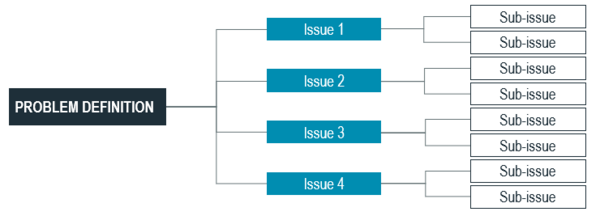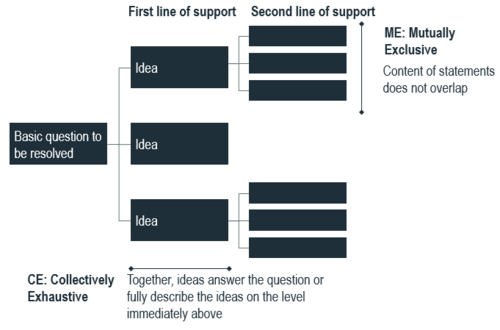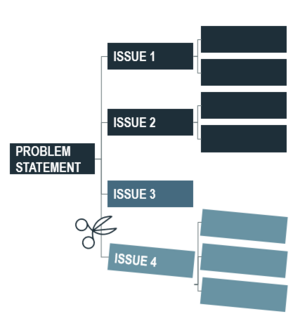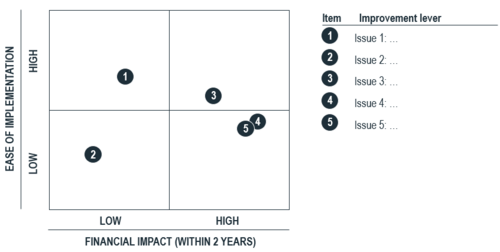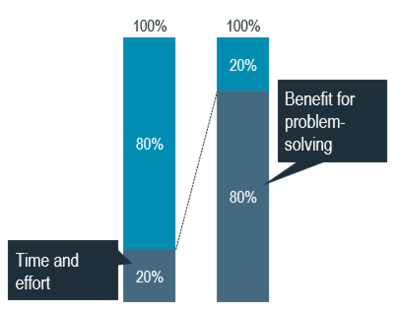APPPM Issue Tree
Contents |
Abstract
This article is mainly about a tool called Logic Issue Tree which is used to identify the problems that a company or any other entity may have.
The proposed methodology involves a hierarchical ranking of the issues, classifying them by degrees of importance, or other variables, which in some cases will lead to the proposal of sub-issues. After defining the main problem of the company, the issues that may be the cause of the problem and, in turn, the sub-issues that may be the cause of the latter, are ranked by degrees of importance. Therefore, Logic Issue Trees break down large complex questions into smaller manageable ones.
Although it may seem an unnecessary process, it is important to have a global vision of the problem in order to be able to attack the different key points and ensure the success of the project.
This methodology also involves a prioritisation phase, once the Logic Issue Tree classification has been completed, which, through the use of a matrix, will allow a separation of the different items detected. This separation will divide the items into four categories, determining which of them to start working with in order to implement an improvement in the company, establishing as parameters the financial impact and the ease of implementation.
In summary, the scope of this article is the drafting of the procedure required to Issue identification and prioritisation. All the tools described in the article are important for this stage of Problem-Solving and if used correctly can lead to the success of the process.
Big Idea
An Issue-driven problem-solving process consists in three phases: identifying, solving and communicating.
Firstly, the identifying phase consists in the problem definition in which the consultor identify which problem to solve, stakeholders that influence the solution and key success criteria for the work ahead.
Next, the solving phase consist in three steps:
- Issue identification and prioritisation. Problems are deconstructed into quantifiable and formal problem statements (issues) that can be prioritized
- Identify hypotheses. Hypotheses are identified and formulated for every issue in order to make analysis possible
- Conduct analyses. Collect data and conduct required analyses
Finally, the process proceed with the last phase which is the communicating. This last part of the Issue-driven problem-solving process consists in synthesizing of findings and developing recommendations. The aim of this phase is to develop clear communication of results and recommended solution.
Due to the complexity and length of this process, this article will focus on the first step of the second phase, Issue identification and prioritisation, by using a methodology that will be called: The Issue Tree. [1]
In a general way, it is a question of deconstructing the problem into quantifiable and formal problem statements (issues) that can be prioritized and prioritising what issues to focus on in the analysis based on each issue’s impact on the overall problem-solving.
Problem definition
A problem is the difference between current and desired end state. It can be said that, before solving a case, one is in the current state in which a problem-solving process must be applied in order to reach the desired state. A problem does not necessarily have to be negative, it can simply be an option to improve the efficiency of the company, such as improving the manufacturing process, evaluating better suppliers, implementing new automotive processes in a factory, etc.
The value creation comes from solving difficult problems by mitigating a number of challenges that a company may face:
- - Not sufficient time. Deadlines are tight, the organisation waits for critical decisions.
- - There are different options. Different people in the organisation see the problem differently and, consequently, people push for different solutions.
- - Too much data. Not known where to start looking or the level of data quality.
- - Not sufficient resources. The problem is to be solved on top of daily work.
- - The problem is not clearly defined. There is more than one problem.
- - Too little insight. Do not have sufficiently granular insights about the market or how it is doing.
The implicit purpose of value creation and of detecting a clear problem leads us to the need to implement a standard methodology that aims to solve in a simple, efficient and concise way any type of business case.
Once the first phase explained above, identification, has been completed, we proceed to the second phase with a definition of the problem. It is assumed that the problem consists of the difference between the expected and the actual state of affairs.
Logic Issue Tree
Within the problem, a number of issues will be identified and prioritised. These are a logical component of a problem, potentially made up of several sub issues that can be analysed and often quantified.
From this difference arises the need to use a Logic Issue Tree, which consists of decomposing the main problem into issues. This scheme offers three main advantages:
- Splits complex problems into (quantifiable) elements that can be analysed
- Provides a visual structure of the problem and ensures that nothing is left out
- Is a good tool for communicating how is seen the world
The Logic Issue Tree is a very useful tool in problem solving. On the one hand, it allows complex problems to be broken down into simpler and more manageable ones. Breaking down problems into smaller, easier to solve areas makes the process much easier.
Secondly, this procedure is excellent for maintaining the relationship between each of the issues and sub-issues. All problem trees are excellent for maintaining focus. Sub-issues are logically connected to the overall issue. When consultants work on a sub-issue, they know that it will contribute to solving the overall problem. Without an issue tree it is easy to get lost in the details and lose sight of whether an activity contributes to solving the overall problem or not.
Third, issue trees are also a great communication tool. They are easy for customers and teams to understand because they are visual. If structured correctly, they also ensure that no potential cause of a problem is overlooked as part of the analysis. This often reassures customers in real life.
MECE principle
In order to build quality into a Logic Issue Tree the MECE principle is used. [2] This theory suggests that all the possible causes or options to be considered in solving these problems can be grouped and categorized in a particular way:
- ME. (Mutually Exclusive) This is a concept related to probability theory which implies that two events cannot occur at the same time. For this reason, when two mutually exclusive ideas are put forward, it implies that they are separate and cannot overlap with each other.
- CE. (Collectively Exhaustive) It implies that the set of ideas includes all possible options. Thus, it means that all entities are considered relevant.
Linking Mutually Exclusive with Collectively Exhaustive allows a large amount of information to be generated and simplified into multiple separate and distinct sets of ideas, the issues and sub-issues. After having verified the quality of the Logic Issue Tree using the MECE principle, it can be said that a structured representation of the problem is available, which was the objective of this second phase step. It basically means your reasoning has no gaps (Collectively Exhaustive, all parts together exhaust the whole) and no overlaps (Mutually Exclusive, one part is different and independent from the other).
Prioritisation Matrix
Then, to conclude this step of the second phase, Issue identification and prioritisation, proceed to prioritise by eliminating issues. The purpose of eliminating issues is:
- To help to prioritise the efforts, identify clearly what is most important.
- To work efficiently and have a better management lifestyle
- To help to ask “so what”, but also ask yourself what you may have forgotten
Eliminating issues can be difficult because team members will have differing opinions on what is critical to the analysis. In order to standardise the process and to take into account all opinions in order to arrive at a better prioritisation, a methodology is again established to be applied.
The tool used to focus the analysis is called Prioritisation Matrix. [3]
First, each of the issues is numbered in items, and each of them is defined with a corresponding improvement lever that will be a short description of the issues. Subsequently, the matrix is filled in.
The matrix consists of 4 boxes that are evaluated according to two parameters. On the x-axis the financial impact is evaluated, usually a fixed period is set in order to be able to evaluate a more tangible result, e.g. a period of two years. On the other hand, on the coordinate axis, the ease of implementation is evaluated. In both cases the evaluation scale is qualitative, from low to high.
The matrix is then filled in. For this purpose, each item is taken and analysed on the basis of its implementation lever. After deciding among the team which is the level of financial impact and ease of implementation, the items will be implemented in the matrix.
Finally, the items will be split in 4 categories:
- Immediate implementation. The items in this category are those in the top right hand corner quadrant, therefore with a high level of financial impact and high level of ease of implementation. These are issues or sub-issues that if implemented can generate a high benefit value and are easy and straightforward to implement. This category identifies the best items to implement and is intended to be set up and planned immediately, involving a significant change in benefits from the outset and very little execution effort.
- Implementation planning. The items in this category are those in the bottom right hand corner quadrant, therefore with a high level of financial impact but with a low level of ease of implementation. These are issues or sub-issues that if implemented can generate a high benefit value but the process needed to its implementation is considered complicated, too costly or both. This category identifies the items in which the immediate implementation is not prioritised, but it is recommended to start a planning process in which the complexity and costs of the process are assessed in order to be able to measure more accurately its potential benefit. This is a category that, coming after having implemented those elements that are easy and beneficial, usually has the financial support to execute its implementation.
- Analyse subsequently. The items in this category are those in the top left hand corner quadrant, therefore with a low level of financial impact but a high level of ease of implementation. These are issues or sub-issues that, even though their implementation is simple and implies a low process cost, its consequently financial impact is not imperative. This category identifies a set of items that could be interesting to analyse subsequently the first two categories. After having considered the ones before, this items would be extremely positive to the problem-solving implementation process because after having executed the other improvements, an added benefit can be done due to this category without too much effort.
- Postpone analysis. The items in this category are those in the bottom left hand corner quadrant, therefore with a low level of financial impact and ease of implementation. These are issues or sub-issues which implementation will be postponed to the end. That fact does not necessary implies that they are not going to be implemented but analysed at the end in order to evaluate if its impact could be significantly positive to the main problem.
This procedure of prioritisation can be approached from different angles. The parameters used in the abscissa and coordinates axes can be changed and focused on the most important topics that wants to be evaluated. Furthermore, this same methodology can be equally applied for the different tracks of the Logic Issue Tree. Thanks to that, using the same prioritization principle all the different issues and sub-issues can be evaluated following the same implementation rules. In order to do a great use of the Prioritisation Matrix, there are some advices to be followed:
- - Use common sense, it is important to be objective and not let one's own ideas or motivations affect prioritisation.
- - Estimate – “back of the envelope” calculations are often very efficient, it is not necessary to do, a full analysis or highly developed calculations, simply an overview expressed in values in order to be able to assess the financial impact.
- - Use the client actively to prioritise and check preconditions/assumptions.
- - Check with the team, it is important that more than one person performs this task together in order to have several points of view and to be able to make a more complete analysis.
- - Trust yourself, remember that your job is to focus.
The 80/20 rule
The 80-20 rule, which is also known as the Pareto Principle [4], is a principle that states that 80% of the results are due to 20% of the initial inputs. More specifically, for this Issue identification and prioritisation step of the Solving phase, this principle is interpreted taking into account that the first 20% of the work carried out to analyse the important points on which to apply an improvement will provide 80% of the solution.
In business, one of the objectives of the 80-20 rule is to identify the inputs that are potentially most beneficial and make them the priority. Hence, once the factors that are critical to a company's success have been clearly identified, maximum attention should be paid to these factors. This is not a specific methodology to be followed, but simply a principle to be taken into account when carrying out the initial steps of problem-solving.
The fact of carrying out a good analysis at the beginning, clearly identifying the issues and sub-issues and making a good study of their prioritisation implies the subsequent success of the project. This is a very important part of the process, as the decisions taken at this stage will be the basis for all subsequent changes and operations in the company. Therefore, in order to make good use of the resources, time and money of the analysis process, it is important to correctly define the problems to be solved so as not to have to go back and rectify them later on.
Application
As it can be seen, the Logic Issue Tree methodology and all their involved principles could be applicable to all problem-solving cases. However, it is important to define how this methodology is useful for a project manager. In order to give a specific application, reference will be made below to the MIP.
The Project Management Institute (PMI) [5] is an American non-profit organisation that brings together Project Management professionals from all over the world. Its main objectives are:
- To formulate professional standards in Project Management.
- To generate knowledge through research.
- Promote Project Management as a profession through its certification programmes.
The Project Management Institute has developed the PMBOK (Project Management Body of Knowledge)[6] guide which contains an overview of the fundamentals of Project Management recognised as best practice for effective and efficient project development. The PMBOK guide describes 49 project management processes which it classifies into 10 knowledge areas (Integration, Scope, Time, Cost, Quality, Resources, Communication, Risk, Procurement and Stakeholders) and 5 process groups (Initiation, Planning, Execution, Monitoring and Control and Closure).
In this particular case, the main application of the subject of this article, the Logic Issue Tree, is, as we already know, its involvement in problem solving, from which an improvement project is subsequently generated. Therefore, in relation to PMBOK, this methodology would form part of the knowledge area of integration.
In it, as in the other areas, the five process groups are dealt with. Of these, only the first two are related to the Logic Issue Tree, so that the initiation and planning phases can be carried out in a standardised, methodical and effective way.
Limitations
Because it is a very generic technique and very easily adaptable to any type of problem or circumstance, it does not present major limitations at the standard level. For each case, different limitations will arise in relation to the problem, but it is not a limitation generated by any of the tools explained in this article, but rather a poor definition of the problem or the difficulty in determining the issues or sub-issues.
What must be taken into account is that there are different types of problems, and although the approach used for all of them will be the same, some may present more complications than others. These types are:
- Well structured. This is the category of problems in which the knowledge domain can be identified. Therefore, we can identify the problem, the objectives and the intermediate stages. On the other hand, we can also identify the obstacles, the steps to solve it and test the proposed solution. Consequently, the problem can be solved using manageable levels of effort and money.
- Poorly structured. These are problems in which the knowledge domain cannot be identified, nor can the problem, objectives and intermediate stages be easily identified. It is not possible to identify the impediments that are blocking the process, nor the steps to solve it, nor to test the proposed solution. Solving the problem requires extra effort and may also involve high monetary investment.[7]
- Wicked problems. This is a category of problems that do not have a definitive formulation because their requirements are incomplete, contradictory or changing. These problems have no criteria that determine the solution, always have more than one explanation and are usually symptoms of other complex problems. On the other hand, they often show a high interdependence with other internal and external elements. There is no complete list of possible moves to find a solution. Each wicked problem is unique and its resolution may reveal or create new problems. The problem-solving process in this case sometimes requires a lot of effort to clarify the problem and the steps to be taken, therefore it may involve a lengthy process of identifying and prioritising the issues and the consequent monetary investment.[8]
Annotated bibliography
The following list provides resources for further research on Logic Issue Trees and all the methodologies and principles explained:
- https://www.craftingcases.com/issue-tree-guide/: Bruno Nogueira: ex-McKinsey consultant.
- - Source that explains in depth the Issue Tree guidelines, the secret to think like a McKinsey consultant and always have a clear, easy way to solve any problem.
- https://en.wikipedia.org/wiki/MECE_principle: Wikipedia
- - Source that explains in depth the MECE principle used for the construction of a quality Logic Issue Tree.
- https://www.fool.com/the-blueprint/prioritization-matrix/: Maricel Rivera: Technology Journalist
- - Source that explains in depth the Prioritisation Matrix used for the detection on impactful items.
- - Source that explains in depth the Pareto Principle used to represent the importance of the Logic Isuue Tree.
- https://www.pmi.org/: Project Management Institute: Official website.
- - Official PMI website where information can be found on both the association and the guide referenced in this article, PMBOK.
- https://cschan.arch.iastate.edu/235/6_Simon_Ill_defined_problem.pdf: Simon, H. (1973) The Structure of Ill Structured Problems. Artificial Intelligence 4 (1973).
- - Resource that explains in more detail the definition of the different types of problems that affect the limitations of this methodology.
- http://files.meetup.com/11447962/Rittel%2BWebber_1973_PolicySciences4-2.pdf: Rittel, H. W.J. & Webber, M.M. (1973) Dilemmas in General Theory of Planning. Policy Sciences 4 (1973).
- - Resource that explains in more detail the definition of the different types of problems that affect the limitations of this methodology.
References
- ↑ [1], The Definitive Guide To Issue Trees, Bruno Nogueira, ex-McKinsey consultant
- ↑ [2], The MECE principle, Wikipedia, January 2021
- ↑ [3], Prioritisation Matrix, Maricel Rivera, Technology Journalist, November 2020
- ↑ [4], Pareto Principle, Wikipedia, February 2021
- ↑ [5], Project Management Institute, Wikipedia, January 2021
- ↑ [6], Project Management Body of Knowledge, Guide – Sixth Edition (2017)
- ↑ [7], The structure of ill structured problems, Herberd A. Simon, 29 October 1973
- ↑ [8], Dilemmas in a general theory of planning, Horst W. J. Rittel, June 1973
